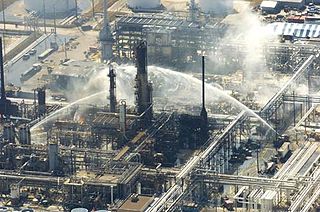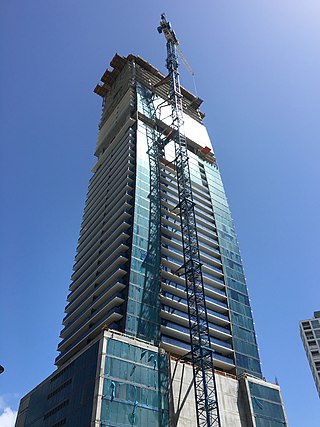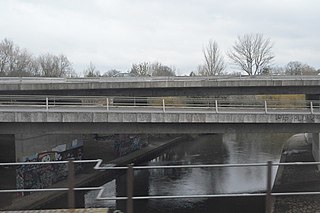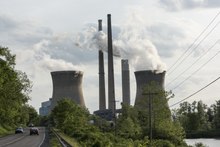
Scaffolding, also called scaffold or staging, is a temporary structure used to support a work crew and materials to aid in the construction, maintenance and repair of buildings, bridges and all other man-made structures. Scaffolds are widely used on site to get access to heights and areas that would be otherwise hard to get to. Unsafe scaffolding has the potential to result in death or serious injury. Scaffolding is also used in adapted forms for formwork and shoring, grandstand seating, concert stages, access/viewing towers, exhibition stands, ski ramps, half pipes and art projects.
The Occupational Safety and Health Administration is a large regulatory agency of the United States Department of Labor that originally had federal visitorial powers to inspect and examine workplaces. The United States Congress established the agency under the Occupational Safety and Health Act, which President Richard M. Nixon signed into law on December 29, 1970. OSHA's mission is to "assure safe and healthy working conditions for working men and women by setting and enforcing standards and by providing training, outreach, education, and assistance." The agency is also charged with enforcing a variety of whistleblower statutes and regulations. OSHA's workplace safety inspections have been shown to reduce injury rates and injury costs without adverse effects on employment, sales, credit ratings, or firm survival.
Construction site safety is an aspect of construction-related activities concerned with protecting construction site workers and others from death, injury, disease or other health-related risks. Construction is an often hazardous, predominantly land-based activity where site workers may be exposed to various risks, some of which remain unrecognized. Site risks can include working at height, moving machinery and materials, power tools and electrical equipment, hazardous substances, plus the effects of excessive noise, dust and vibration. The leading causes of construction site fatalities are falls, electrocutions, crush injuries, and caught-between injuries.

The Texas City Refinery explosion occurred on March 23, 2005, when a vapor cloud of natural gas and petroleum ignited and violently exploded at the isomerization (ISOM) process unit at the BP Texas City refinery in Texas City, Texas, killing 15 workers, injuring 180 others and severely damaging the refinery. The Texas City Refinery was the second-largest oil refinery in the state, and the third-largest in the United States with an input capacity of 437,000 barrels (69,500 m3) per day as of January 1, 2000. BP acquired the Texas City refinery as part of its merger with Amoco in 1999.
The L'Ambiance Plaza collapse was one of the worst disasters in modern Connecticut history. L'Ambiance Plaza was a 16-story residential project under construction in Bridgeport, Connecticut, at the corner of Washington Avenue and Coleman Street. Its partially erect frame completely collapsed on April 23, 1987, killing 28 construction workers. Failure was possibly due to high concrete stresses on the floor slabs by the placement process resulting in cracking, ending in a type of punch-through failure. Several observers suggested the collapse was preventable and highlighted the deficiencies of the lift slab construction technique. This collapse prompted a major nationwide federal investigation into lift slab construction as well as a temporary moratorium on its use in Connecticut.

Plant Bowen, commonly known as Bowen Steam Plant, is a coal-fired power station located just outside Euharlee, Georgia, United States, approximately 8.7 mi (14 km) west-south-west from Cartersville. At over 3,450 megawatts, Plant Bowen is one of the largest coal-fired power plants in North America. The station is connected to the southeastern power grid by numerous 500 kV transmission lines, and is owned and operated by Georgia Power, a subsidiary of Southern Company.

State Road 912 (SR 912), known along its entire length as Cline Avenue, is a freeway north of the combined Interstate 80/I-94/U.S. Route 6, and a local access road serving Griffith south of the Borman. The portion of Cline Avenue marked as SR 912 is 11.69 miles (18.81 km) long.
On 23 October, 1989 at approximately 1:05 PM Central Daylight Time, a series of explosions occurred at Phillips Petroleum Company's Houston Chemical Complex in Pasadena, Texas, near the Houston Ship Channel. The initial blast registered 3.5 on the Richter scale, and the resulting fires took 10 hours to bring under control, as efforts to battle the fire were hindered due to damaged water pipes for the fire hydrants from the blast. The initial explosion was found to have resulted from a release of extremely flammable process gasses used to produce high-density polyethylene, a plastic used for various consumer food container products. The US Occupational Safety and Health Administration fined Phillips Petroleum Company $5,666,200 and fined Fish Engineering and Construction, inc, the maintenance contractor, $729,600. The event killed 23 employees and injured 314.

On March 2, 1973, the 26-story Skyline Plaza condominium building, under construction in Bailey's Crossroads in Fairfax County, Virginia, collapsed, killing 14 construction workers and injuring 35 others.

On 7 February 2008, fourteen people were killed and forty injured during a dust explosion at an Imperial Sugar owned refinery in Port Wentworth, Georgia, United States. Dust explosions had been an issue of concern among U.S. authorities since three fatal accidents in 2003, with efforts made to improve safety and reduce the risk of reoccurrence.

Jack Raymond Janney, born in Alamosa, Colorado, was a U.S. structural engineer and an innovator in the understanding of structural behavior and a recognized leader in the investigation of structural collapses. Janney's love of mathematics and science spurred his decision to become an engineer, and in 1942, he enrolled in the College of Engineering at the University of Colorado at Boulder. After only one semester, Janney left college and enlisted in the Navy where he became a decorated pilot during World War II.

Pleasants Power Station is a 1.3-gigawatt coal power plant located near Belmont, West Virginia in Pleasants County, West Virginia. The plant is owned by Energy Harbor and began operations in 1979. The power plant was the site of the Willow Island disaster in 1978.
Willow Island is an unincorporated community in Pleasants County, West Virginia, United States. Willow Island is located on the Ohio River at the junction of West Virginia Route 2 and County Highway 10, 3 miles (4.8 km) west-southwest of Belmont. Willow Island had a post office, which opened on October 17, 1946, and closed on May 25, 1991. The Pleasants Power Station, site of the 1978 Willow Island disaster, is located in Willow Island. This is the location of Willow Island Baptist Church and Willow Island Cemetery, the burial site for many of the area's founding and prominent families. Willow Island was also the location of Cyanamid; later called Cytec Industries, a chemical plant and a large contributor to the Pleasants County school system and area's work force.

Echo Brickell is a skyscraper in the Brickell district of Downtown Miami, Florida, United States. It was developed by Kevin P. Maloney's Property Markets Group.

The Fengcheng power station collapse occurred on 24 November 2016. At least 74 people died and at least two others were injured and trapped after a construction platform at a power plant in the Chinese city of Fengcheng in Jiangxi province collapsed. During the time, more than 60 people were working on the platform and another dozen were on the ground waiting to begin their shift at 7a.m. when the platform of a power plant’s cooling tower under construction collapsed.

Workplace robotics safety is an aspect of occupational safety and health when robots are used in the workplace. This includes traditional industrial robots as well as emerging technologies such as drone aircraft and wearable robotic exoskeletons. Types of accidents include collisions, crushing, and injuries from mechanical parts. Hazard controls include physical barriers, good work practices, and proper maintenance. Previous research showed that robot application is associated with an increase in the rate of occupational injuries in the first two years, and then becomes insignificant and even negative afterwards. Local governments can reduce or even eliminate the effect of robot application on occupational injuries by strengthening safety regulations. In addition, although local governments are keen on pushing robot application and industrial intelligence, the wide application of robots may impose a burden on the public health expenditure of local governments due to occupational injuries.

The Florida International University pedestrian bridge collapse occurred on March 15, 2018, when a 175-foot-long section of the FIU-Sweetwater UniversityCity Pedestrian Bridge collapsed while under construction. The collapse resulted in six deaths, ten injuries, and eight vehicles being crushed underneath. Of the serious injuries, one employee was permanently disabled. At the time of the collapse, six lanes of road beneath the bridge were open to traffic.
An explosion at the ARCO Chemical (ACC) Channelview, Texas petrochemical plant killed 17 people and injured five others on July 5, 1990. It was one of the deadliest industrial disasters in the history of the Greater Houston area.

The Loddon Bridge disaster was a collapse of falsework during construction of a reinforced concrete deck on the Loddon Bridge of the A329(M) motorway in Berkshire, England, on 24 October 1972. It killed three people and injured ten others. It is thought that a design error led part of the falsework, transitioning between the deck and the supporting towers, to be understrength and it failed by buckling or twisting. The part-poured deck fell into the river below. The collapse was investigated by Her Majesty's Factory Inspectorate and the contractor, Marples Ridgway pled guilty to a breach of the construction regulations at a trial in Bracknell, being fined £150.














